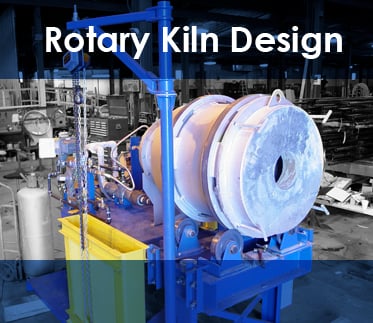Rotary kilns are widely used throughout many industries to carry out various chemical reactions and physical changes in bulk solids. As all materials respond differently, rotary kilns must be designed around the exact project specifications and material characteristics at hand in order to reach an optimal processing solution.
The highly complex process of sizing a commercial-scale kiln combines data (and often testing) with engineering principles and experience to engineer a kiln that meets its intended processing goal.
Data Acquisition
The first step in sizing a rotary kiln entails thermal and chemical analyses that gather information on reaction temperatures, heat transfer properties, potential unintended reactions, and more. Depending on the process and the material, some of this data may be published.
Upon completion of a thorough thermal and chemical analysis, additional data is gathered around the source material and the many process variables that can influence it during processing.
Much of the data required to size a commercial-scale kiln can be gathered through proven testing methods, such as those employed in the FEECO Innovation Center. Here, process conditions are simulated in a variety of batch- and pilot-scale kilns to analyze and determine data points such as:
- Air flow velocity
- Drum slope
- Feed rate
- Temperature profiles
- Residence time
- Rotational speed
- And more….
Determining Kiln Size
The data acquired from testing is then combined with engineering principles and the unique experience of FEECO’s thermal processing experts.
The size of a rotary kiln is not only a function of capacity, but also of the amount of heat that can be generated inside the rotary kiln from the volatizing and/or combustion of the material being processed.
Diameter and length are calculated based on the maximum feed rate, the required retention time, and what the bed profile (how full of material the rotary kiln is) will need to look like, among other contributing factors.
In the FEECO design process, once we have engineered a rough design of the rotary kiln, we use several computer programs to help predict and model how the material will behave in the rotary kiln we have designed. We review the combined analyses, and if our design does not meet the appropriate criteria, we adjust accordingly.
Conclusion
Rotary kilns are a vital part of industrial processing, helping to carry out a wide range of chemical reactions and physical changes in hundreds of materials. The process of sizing a rotary kiln to meet the specific requirements of a given application is incredibly complex, and must take several factors and analyses into consideration.
FEECO is a world leader in engineering and manufacturing advanced thermal processing systems. Our custom rotary kilns are built to the highest quality standard and are backed by our unmatched expertise. For more information on our testing capabilities or custom rotary kilns, contact us today!



